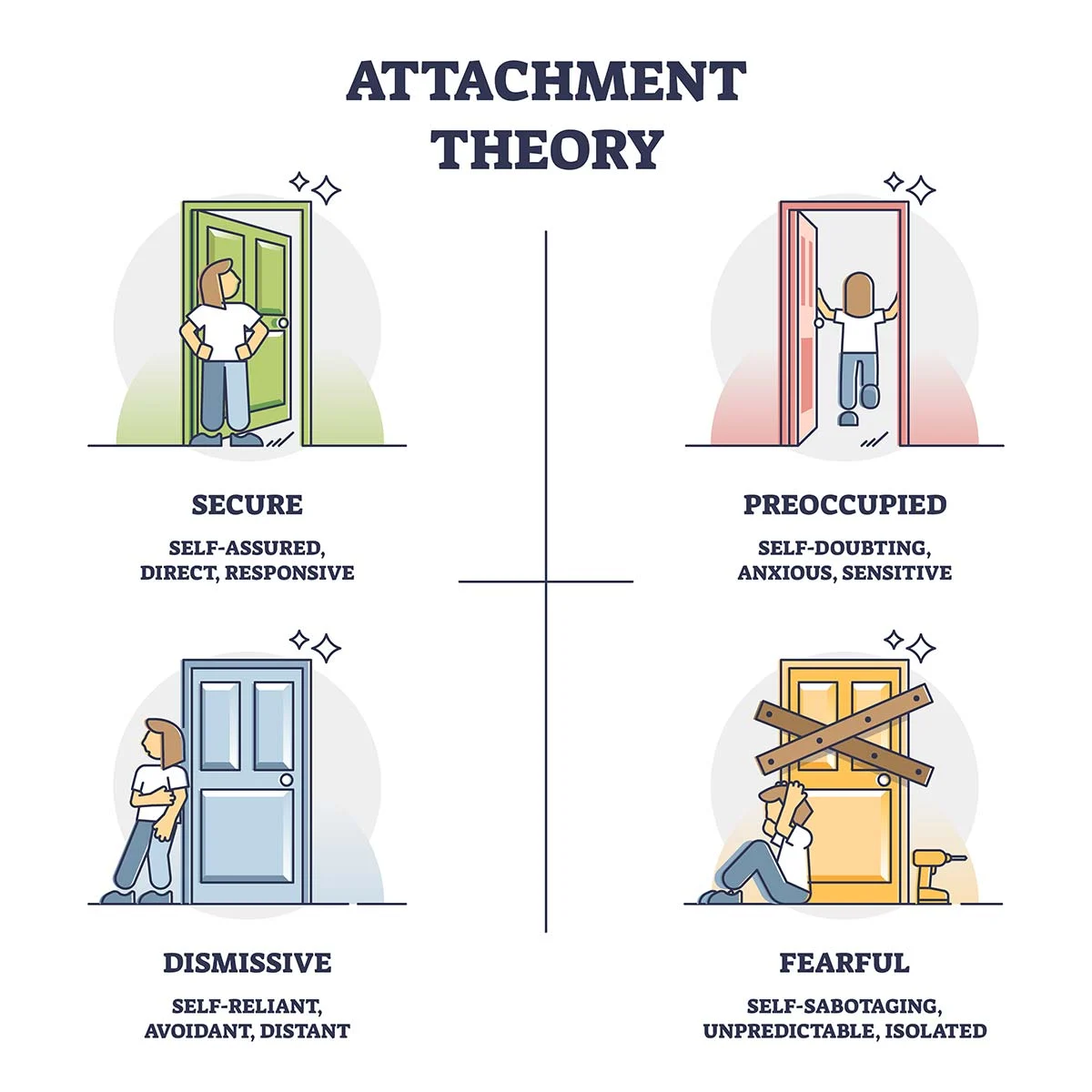
The Foundation of Attachment Theory
Understanding attachment theory and its styles is crucial for comprehending how we relate to others in our adult relationships. These styles are deeply rooted in our early experiences and shape the way we approach intimacy, trust, and connection. In this blog post, we’ll delve into the foundation of attachment styles, exploring their origins and significance in shaping our relational dynamics.
Attachment theory, pioneered by John Bowlby and further developed by Mary Ainsworth, explores how early interactions with caregivers influence our emotional bonds and attachment patterns. The quality of care received during infancy lays the groundwork for our attachment style, impacting our beliefs about ourselves and others.
Individuals with a secure attachment style typically had caregivers who were consistently responsive to their needs, providing comfort and support. As a result, they develop a positive view of themselves and others, feel comfortable with intimacy, and can effectively regulate their emotions.
Fearful attachment, also known as disorganized attachment, often stems from inconsistent or traumatic caregiving experiences. These individuals may exhibit conflicting behaviours, craving closeness while fearing rejection or harm. Fearful attachment can lead to difficulties in trusting others and forming stable relationships.
Preoccupied attachment, sometimes referred to as anxious or ambivalent attachment, arises from caregivers who were inconsistently responsive. These individuals may crave intimacy and validation but also harbour fears of abandonment. They tend to be preoccupied with their relationships and seek constant reassurance from their partners.
Dismissive attachment, also called avoidant attachment, typically results from caregivers who were emotionally unavailable or rejecting. Individuals with this attachment style often value independence and self-reliance, suppressing their emotions and avoiding intimacy to protect themselves from potential hurt.
Our attachment style significantly influences how we engage in romantic partnerships, shaping our communication patterns, conflict resolution strategies, and emotional responses. Recognizing our attachment style and understanding its impact can help us navigate relationship challenges more effectively.
The foundation of attachment styles lies in our early experiences with caregivers and profoundly influences our adult relationships. By gaining insight into our attachment patterns, we can cultivate healthier dynamics, foster secure connections, and ultimately enhance the quality of our relationships.
Secure Attachment
Secure attachment is often regarded as the gold standard for relational dynamics, characterized by trust, intimacy, and emotional security. Individuals with secure attachment feel comfortable both with closeness and independence, enabling them to form deep, meaningful connections with others while maintaining a strong sense of self. In this blog post, we’ll explore what secure attachment entails, its benefits in relationships, and how individuals can cultivate and maintain a secure attachment style.
Secure attachment is rooted in a sense of trust and reliability in relationships, developed through consistent emotional responsiveness and support from caregivers during infancy and childhood. Securely attached individuals feel confident in expressing their needs and emotions, knowing they will be met with understanding and care. This foundation of security allows them to form healthy, lasting bonds with others based on mutual respect, empathy, and reciprocity.
Characteristics of Secure Attachment:
- Emotional Availability:
- Securely attached individuals are emotionally attuned to themselves and others, able to express their feelings openly and respond empathetically to the emotions of their partners.
- They feel comfortable seeking support and comfort from their loved ones when needed, knowing they will receive validation and understanding in return.
- Trust and Reliability:
- Trust is a fundamental aspect of secure attachment, as securely attached individuals have confidence in the reliability and consistency of their relationships.
- They believe their partners will be there for them during times of need, fostering a sense of security and stability in the relationship.
- Effective Communication:
- Securely attached individuals excel in communication, expressing their needs, desires, and boundaries clearly and assertively.
- They are adept at resolving conflicts constructively, approaching disagreements with empathy, understanding, and a willingness to compromise.
- Autonomy and Interdependence:
- Secure attachment allows individuals to balance autonomy and interdependence in relationships, valuing both independence and connection.
- They maintain a strong sense of self while also fostering intimacy and closeness with their partners, recognizing the importance of maintaining personal boundaries and self-care.
- Emotional Availability:
Secure attachment lays the groundwork for healthy, fulfilling relationships, offering numerous benefits for individuals and their partners:
- Greater emotional resilience and well-being
- Increased intimacy and connection in relationships
- Improved conflict resolution skills and communication
- Enhanced trust and commitment
- Reduced anxiety and insecurity in relationships
While secure attachment often begins in childhood, it is a dynamic and malleable aspect of personality that can be cultivated and strengthened throughout life:
- Practice self-awareness and emotional regulation
- Foster open, honest communication in relationships
- Prioritize empathy, understanding, and validation
- Seek out supportive relationships and cultivate a strong support network
- Engage in activities that promote self-care and personal growth
Secure attachment forms the cornerstone of healthy, fulfilling relationships, providing individuals with a sense of safety, trust, and emotional security in their connections with others. By understanding the characteristics of secure attachment and cultivating these qualities in ourselves and our relationships, we can build stronger, more resilient bonds that withstand the challenges of life and nurture mutual growth and fulfilment.
Anxious Attachment
Anxious attachment, also known as preoccupied or ambivalent attachment, is one of the four primary attachment styles that shape our relational behaviours and experiences. Individuals with an anxious attachment style often struggle with fears of abandonment, seek excessive reassurance, and may exhibit clingy or demanding behaviour in relationships. In this blog post, we’ll delve deeper into the characteristics, origins, and implications of anxious attachment.
Anxious attachment is characterized by a strong desire for closeness and intimacy coupled with fears of rejection or abandonment. Individuals with this attachment style may constantly seek validation and reassurance from their partners, worrying about the stability of their relationships. They may also exhibit heightened emotional reactivity and struggle with self-esteem issues, depending on external validation to feel worthy and lovable.
The development of an anxious attachment style often traces back to inconsistent or unpredictable caregiving during childhood. Caregivers who were intermittently responsive to a child’s needs or emotionally unavailable can instil a sense of insecurity and unpredictability. As a result, children learn to hyper-focus on their caregivers’ behaviours, developing strategies to elicit attention and affection to meet their emotional needs.
Anxious attachment can significantly impact adult relationships, influencing communication patterns, conflict resolution strategies, and emotional regulation. Individuals with this attachment style may struggle with trust issues, constantly seeking validation and reassurance from their partners. They may also experience intense emotional highs and lows, fearing rejection and interpreting benign behaviours as signs of abandonment.
While seeking closeness and intimacy, individuals with an anxious attachment may inadvertently push their partners away through their clingy or demanding behaviour. They may struggle to maintain boundaries and may become overly dependent on their partners for emotional fulfilment, leading to codependent dynamics. Additionally, the fear of rejection may hinder their ability to express their needs and assert themselves in relationships.
Recognizing and understanding anxious attachment is the first step toward overcoming its challenges. Therapy, mindfulness practices, and self-reflection can help individuals develop greater self-awareness and cultivate healthier relationship dynamics. Learning to regulate emotions, communicate effectively, and establish secure boundaries can empower individuals to form more satisfying and fulfilling connections.
Anxious attachment can pose challenges in relationships, but with awareness and intentional effort, individuals can learn to navigate their attachment patterns and cultivate more secure and satisfying connections. By seeking support, practising self-awareness, and developing healthy coping mechanisms, individuals can overcome the limitations of anxious attachment and build resilient and fulfilling relationships.
If you resonate with the characteristics of anxious attachment and are seeking support in navigating your relationship dynamics, consider reaching out to a qualified therapist or relationship coach. Through personalized guidance and support, you can embark on a journey of self-discovery and growth, transforming anxious attachment patterns into opportunities for deeper connection and fulfilment in your relationships.
Avoidant Attachment
Avoidant attachment, also referred to as dismissive attachment, is one of the four primary attachment styles that influence how individuals connect and relate in relationships. Individuals with an avoidant attachment style tend to prioritize independence, suppress emotional needs, and maintain emotional distance from their partners. In this blog post, we’ll explore the characteristics, origins, and implications of avoidant attachment, shedding light on the challenges and opportunities for growth it presents in relationships.
Avoidant attachment is characterized by a strong inclination toward self-reliance and a reluctance to depend on others for emotional support or intimacy. Individuals with this attachment style often suppress their emotions, preferring to deal with challenges independently rather than seeking comfort or reassurance from their partners. They may also prioritize personal space and autonomy, maintaining a sense of distance in their relationships to avoid vulnerability or dependency.
The development of avoidant attachment can often be traced back to experiences of emotional neglect or inconsistent caregiving during childhood. Caregivers who were unresponsive to a child’s emotional needs or dismissive of their expressions of vulnerability may inadvertently teach the child to suppress their emotions and develop self-reliant coping strategies. As a result, individuals with avoidant attachment may struggle to trust others and form close emotional bonds.
Avoidant attachment can significantly impact adult relationships, influencing communication patterns, intimacy levels, and conflict resolution strategies. Individuals with this attachment style may struggle with emotional intimacy, maintaining emotional distance to protect themselves from perceived vulnerability or rejection. They may also have difficulty expressing their feelings or needs, fearing that doing so will compromise their independence or autonomy.
While striving for independence and self-sufficiency, individuals with an avoidant attachment may inadvertently create barriers to intimacy and emotional connection in their relationships. They may avoid vulnerability or emotional expression, leading their partners to feel neglected or unimportant. Additionally, their reluctance to rely on others for support or comfort can hinder the development of trust and intimacy, perpetuating cycles of emotional distance and relational dissatisfaction.
Overcoming avoidant attachment involves cultivating self-awareness, developing trust in oneself and others, and learning to embrace vulnerability and emotional intimacy. Therapy, mindfulness practices, and communication skills training can help individuals explore the root causes of their attachment patterns and develop healthier ways of relating to themselves and others. By challenging limiting beliefs and building secure attachment experiences, individuals can create more fulfilling and satisfying relationships.
Avoidant attachment presents unique challenges in relationships, but with awareness and intentional effort, individuals can overcome its limitations and cultivate more secure and satisfying connections. By exploring the origins of their attachment patterns, practising vulnerability, and seeking support when needed, individuals can transform avoidant attachment into an opportunity for growth and deeper intimacy in their relationships.
If you recognize patterns of avoidant attachment in your relationships and are seeking support in navigating your attachment style, consider reaching out to a qualified therapist or relationship coach. Through personalized guidance and support, you can embark on a journey of self-discovery and transformation, fostering greater intimacy and connection in your relationships.
Disorganized Attachment
Disorganized attachment, sometimes referred to as unresolved attachment, is a unique attachment style characterized by contradictory behaviours and a lack of coherent attachment strategies. Individuals with a disorganized attachment may exhibit a mix of anxious, avoidant, or ambivalent behaviours, often resulting from experiences of trauma, neglect, or inconsistent caregiving. In this blog post, we’ll explore the complexities of disorganized attachment, its origins, and its implications for adult relationships.
Disorganized attachment is marked by a lack of consistent attachment behaviours, leading individuals to display conflicting patterns of relating to their caregivers and others. They may alternate between seeking proximity and avoiding contact, expressing ambivalence or confusion in their relationships. Individuals with a disorganized attachment may also exhibit disoriented behaviours, such as freezing or appearing dazed during moments of stress or emotional distress.
Disorganized attachment often arises from experiences of trauma, abuse, or neglect during infancy or childhood. Caregivers who are unpredictable, frightening, or emotionally unavailable can create a sense of fear and confusion in the child, undermining their ability to develop a coherent attachment strategy. Traumatic experiences, such as witnessing violence or experiencing loss, can further disrupt the formation of secure attachment bonds, leading to disorganized attachment patterns.
Disorganized attachment can have profound implications for adult relationships, affecting communication, trust, and emotional intimacy. Individuals with disorganized attachment may struggle to maintain stable, satisfying relationships, experiencing confusion or fear in response to intimacy or emotional vulnerability. They may also exhibit self-destructive behaviours or engage in abusive relationships, perpetuating cycles of trauma and relational dysfunction.
Individuals with disorganized attachment may employ a variety of coping mechanisms to manage their relational difficulties, including avoidance, dissociation, or aggression. These coping strategies, while initially protective, can ultimately undermine their ability to form healthy, secure attachments and maintain fulfilling relationships. Overcoming disorganized attachment requires a combination of self-awareness, therapeutic intervention, and relational support to heal past wounds and develop more adaptive coping strategies.
Healing from disorganized attachment involves acknowledging past traumas, exploring their impact on current relational patterns, and cultivating a sense of safety and security in relationships. Therapy, particularly trauma-informed approaches such as attachment-focused therapy or EMDR (Eye Movement Desensitization and Reprocessing), can provide individuals with the tools and support they need to process traumatic experiences, regulate their emotions, and develop healthier attachment strategies.
Disorganized attachment poses significant challenges in relationships, but with awareness, support, and therapeutic intervention, individuals can overcome its effects and cultivate more secure and satisfying connections. By addressing past traumas, building self-awareness, and learning to trust themselves and others, individuals can transform disorganized attachment into an opportunity for growth and healing in their relationships.
If you recognize patterns of disorganized attachment in your relationships and are seeking support in healing from past traumas, consider reaching out to a qualified therapist or mental health professional. Through compassionate guidance and evidence-based interventions, you can embark on a journey of healing and transformation, fostering greater resilience and intimacy in your relationships.
Recognizing Attachment Patterns in Relationships
Understanding attachment patterns is crucial for navigating the complexities of relationships. Attachment theory proposes that our early caregiving experiences shape our attachment styles, influencing how we relate to others in adulthood. By recognizing and understanding these attachment patterns, individuals can gain insight into their relational dynamics and work towards building healthier, more fulfilling connections. In this blog post, we’ll explore how to recognize different attachment patterns in relationships and their impact on interpersonal dynamics.
Identifying Attachment Patterns:
Secure Attachment:
- Individuals with secure attachment feel comfortable with intimacy and independence, trusting their partners and expressing their needs openly.
- Signs of secure attachment include effective communication, emotional responsiveness, and a balanced approach to relationships.
- Securely attached individuals are able to navigate conflicts constructively, seeking resolution while maintaining a sense of connection and support.
Anxious Attachment:
- Anxious attachment is characterized by a fear of abandonment and a constant need for reassurance and validation from partners.
- Signs of anxious attachment include clinginess, jealousy, and a tendency to overanalyze or misinterpret relationship cues.
- Individuals with anxious attachment may experience heightened emotional reactivity and insecurity, leading to difficulties in maintaining boundaries and self-esteem.
Avoidant Attachment:
- Avoidant attachment involves a reluctance to rely on others or open up emotionally, often stemming from a fear of intimacy and vulnerability.
- Signs of avoidant attachment include emotional distance, reluctance to commit, and a preference for independence or self-sufficiency.
- Individuals with an avoidant attachment may prioritize autonomy and self-protection, struggling to engage in deep emotional intimacy or establish lasting connections.
-
Disorganized Attachment:
- Disorganized attachment combines elements of anxious and avoidant attachment, resulting in contradictory behaviours and unresolved emotional conflicts.
- Signs of disorganized attachment include erratic behaviour, difficulty trusting others, and a tendency to vacillate between seeking and avoiding closeness.
- Individuals with disorganized attachment may exhibit self-sabotaging tendencies, struggling to maintain stable, secure relationships due to unresolved trauma or attachment wounds.
Impact on Interpersonal Dynamics: Understanding attachment patterns can shed light on recurring patterns of behaviour and communication in relationships. Couples with complementary attachment styles may experience greater harmony and understanding, while those with conflicting attachment styles may face challenges in meeting each other’s needs and resolving conflicts effectively. Recognizing attachment patterns allows individuals to cultivate greater empathy, compassion, and self-awareness in their relationships, fostering healthier and more secure attachments over time.
Recognizing attachment patterns in relationships is an essential step towards building healthier and more fulfilling connections with others. By understanding how our early attachment experiences shape our relational dynamics, we can develop greater insight into our own behaviour and communication style, as well as that of our partners. With awareness and intentional effort, individuals can work towards creating secure, supportive relationships that nurture growth, intimacy, and mutual fulfilment.
Nurturing Secure Attachment in Relationships
Building secure attachment in relationships is essential for fostering trust, intimacy, and emotional connection. Whether in romantic partnerships, friendships, or familial bonds, nurturing secure attachment lays the foundation for healthy and fulfilling interactions. In this blog post, we’ll explore practical strategies for cultivating secure attachment in relationships, promoting emotional safety, and strengthening the bonds between partners.
Creating Emotional Safety:
Open Communication:
- Encourage open and honest communication by creating a safe space for sharing thoughts, feelings, and concerns without fear of judgment or criticism.
- Practice active listening and empathy, validating your partner’s experiences and perspectives to foster mutual understanding and connection.
Consistency and Reliability:
- Be consistent and reliable in your words and actions, honouring commitments and following through on promises.
- Establish predictable routines and rituals within the relationship to provide a sense of stability and security.
Emotional Responsiveness:
- Respond promptly and sensitively to your partner’s emotional needs, offering comfort, reassurance, and support during times of distress or vulnerability.
- Demonstrate empathy and understanding by acknowledging and validating your partner’s feelings, even if you may not agree with their perspective.
Building Trust and Intimacy:
Transparency and Honesty:
- Foster trust and transparency by being honest and authentic in your interactions, and sharing your thoughts, feelings, and experiences openly and candidly.
- Avoid keeping secrets or withholding important information, as this can erode trust and undermine the foundation of the relationship.
Vulnerability and Acceptance:
- Cultivate vulnerability by sharing your fears, insecurities, and vulnerabilities with your partner, allowing them to see and accept you for who you are.
- Create a non-judgmental and accepting environment where both partners feel safe to express their authentic selves without fear of rejection or abandonment.
Mutual Respect and Empowerment:
- Foster mutual respect and empowerment within the relationship by honouring each other’s autonomy, boundaries, and individuality.
- Avoid engaging in controlling or manipulative behaviours, instead prioritizing collaboration, compromise, and mutual decision-making.
Practicing Emotional Regulation:
Self-Awareness and Mindfulness:
- Cultivate self-awareness and mindfulness by tuning into your own emotions, thoughts, and bodily sensations, and recognizing how they influence your interactions with your partner.
- Practice self-regulation techniques such as deep breathing, meditation, or progressive muscle relaxation to manage stress and anxiety during times of conflict or tension.
Conflict Resolution Skills:
- Develop effective conflict resolution skills by learning to communicate assertively, listen actively, and negotiate mutually satisfactory solutions.
- Approach conflicts with curiosity and a willingness to understand your partner’s perspective, seeking common ground and compromise rather than escalating tensions.
Nurturing secure attachment in relationships requires ongoing effort, patience, and commitment from both partners. By prioritizing open communication, emotional responsiveness, trust, and mutual respect, couples can create a strong foundation of emotional safety and intimacy. Through mindful practice and intentional efforts to nurture their connection, partners can cultivate a deeper sense of security and fulfilment in their relationship.
Conclusion
In conclusion, nurturing secure attachment in relationships is a vital component of fostering trust, intimacy, and emotional connection. By prioritizing open communication, consistency, emotional responsiveness, and mutual respect, couples can create a strong foundation for lasting love and fulfilment. Building secure attachment takes time, effort, and commitment from both partners, but the rewards of deeper intimacy and emotional safety are well worth the investment.
If you find yourself struggling to nurture secure attachment in your relationship or facing challenges in communication, trust-building, or emotional regulation, consider seeking support from a qualified relationship coach. Through personalized guidance, practical strategies, and empathetic understanding, a relationship coach can help you navigate difficult dynamics, strengthen your connection, and cultivate a healthier, more fulfilling relationship. Take the first step towards a brighter future together by booking a coaching session today. Your journey towards greater love and intimacy starts here.
Disclaimer
In situations where one partner is open and vulnerable in communication and relationship while the other remains closed, it’s essential for the open partner to exercise caution. While vulnerability can foster intimacy and connection, it’s crucial to ensure that it’s reciprocated healthily and respectfully. Being open doesn’t mean being naive or disregarding boundaries. It’s about sharing one’s thoughts, feelings, and needs authentically while also being mindful of the dynamics in the relationship.
However, if the closed partner consistently maintains emotional distance or refuses to engage in open communication, it may be necessary for the open partner to establish boundaries and seek support to address the underlying issues in the relationship. Ultimately, both partners should strive for mutual vulnerability and openness to cultivate a healthy and fulfilling connection.


 Title
Title  Date
Date Category
Category